Don’t Look Now: Witches, Weird Sisters, and the Eroticism of ESP
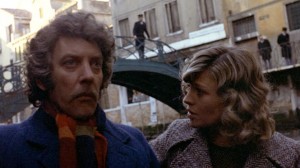
Nicolas Roeg’s 1973 paranormal thriller Don’t Look Now, based on a Daphne du Maurier short story (and now finally released on the Criterion Collection), is one of my desert-island top 10 (probably top 5) favorite films, and it is hands down the greatest Fortean film ever made. Short of UFOs, it has everything you could ever want: premonition, synchronicity, spirit mediums, a murderous dwarf, and the hottest sex scene ever shown on film. It also makes a very interesting argument about the fatal mistake of materialist skepticism, and why it may involve a particularly male fear of female enjoyment.
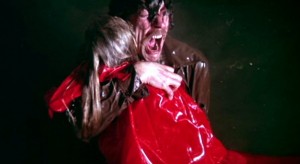 Donald Sutherland plays John Baxter, a Canadian architect working on a church restoration in Venice with his wife Laura (Julie Christie) following the death of their daughter in England some months previous. John is an adoring husband but also a hardheaded skeptic who fails to notice or acknowledge his own psychic abilities, despite having an unmistakeable premonition of his daughter’s drowning at the beginning of the movie. In Venice, a blind psychic Laura meets in a restaurant informs her that their dead daughter’s spirit is present and trying to warn John of danger. Knowing their daughter’s spirit is with them breaks Laura’s depression, but John is arrogantly dismissive and refuses to take any of it seriously.
Donald Sutherland plays John Baxter, a Canadian architect working on a church restoration in Venice with his wife Laura (Julie Christie) following the death of their daughter in England some months previous. John is an adoring husband but also a hardheaded skeptic who fails to notice or acknowledge his own psychic abilities, despite having an unmistakeable premonition of his daughter’s drowning at the beginning of the movie. In Venice, a blind psychic Laura meets in a restaurant informs her that their dead daughter’s spirit is present and trying to warn John of danger. Knowing their daughter’s spirit is with them breaks Laura’s depression, but John is arrogantly dismissive and refuses to take any of it seriously.
 [Spoiler alert: If you haven’t seen the movie, don’t read this paragraph and rent the film first; I need to discuss the twist ending because it is key to my argument.] Laura leaves Venice to visit their son in England, who has had a minor accident, but after her flight John thinks he sees her on a canal, dressed in black, accompanied by the creepy psychic and the psychic’s sister. Thinking his wife has been abducted by these strange women, he enlists the police to track the women down, even though the police are preoccupied with a much more important case: solving a series of murders that has been occurring in Venice’s maze of canals. When Laura calls him from England before returning to Venice, he is bewildered and confused. On his way to meet her when she returns to Venice that evening, he winds up chasing down a child who is wearing a red mackintosh coat like his daughter’s; this “child” turns out to be a crazy old woman, the serial killer, who fatally slashes his throat with a knife. The last scene of the film is Laura (in mourning) and the strange sisters on a boat heading to John’s funeral—the very thing John had seen earlier that day and mistaken for (present) reality.
[Spoiler alert: If you haven’t seen the movie, don’t read this paragraph and rent the film first; I need to discuss the twist ending because it is key to my argument.] Laura leaves Venice to visit their son in England, who has had a minor accident, but after her flight John thinks he sees her on a canal, dressed in black, accompanied by the creepy psychic and the psychic’s sister. Thinking his wife has been abducted by these strange women, he enlists the police to track the women down, even though the police are preoccupied with a much more important case: solving a series of murders that has been occurring in Venice’s maze of canals. When Laura calls him from England before returning to Venice, he is bewildered and confused. On his way to meet her when she returns to Venice that evening, he winds up chasing down a child who is wearing a red mackintosh coat like his daughter’s; this “child” turns out to be a crazy old woman, the serial killer, who fatally slashes his throat with a knife. The last scene of the film is Laura (in mourning) and the strange sisters on a boat heading to John’s funeral—the very thing John had seen earlier that day and mistaken for (present) reality.
Female enjoyment is something that men really, deep down, suspect doesn’t involve or require men at all.
I have been writing lately about how apparent synchronicities may arise from our ‘temporal bias,’ and failure to acknowledge the (scientifically supported, if you believe the science) presence of future traumatic information in our unconscious. No film could better illustrate this: John clearly is ‘gifted’ psychically, but he resolutely refuses to interpret his experience in anything other than straightforward temporal-causal terms, and this blindness to his own abilities (i.e., looking only in the now) has tragic results.
What is even more interesting to me about Don’t Look Now, though, is its suggestion—never explicit but ingeniously hinted at in Nic Roeg’s inimitable way—that John’s distrust of the “weird sisters” goes beyond his rational distaste for the woo they spout and involves a kind of vague sexual/homophobic paranoia. He never says it, but he clearly fears that Laura’s fascination with these menopausal mystics goes beyond them enabling her to make peace with the loss of their daughter—dimly, even unconsciously, he fears these women (are they really sisters?) have drawn his wife into some kind of lesbian coven.
Happy Mediums
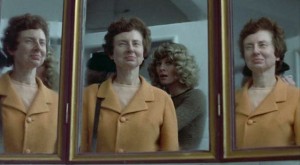 Historically and cross-culturally, spirit mediumship is often associated with females. Anthropologists have frequently focused on how channeling spirits may serve as a mode of political, sexual, and economic assertion in male-dominated worlds: A woman wants a pretty necklace, so through her an Ancestor spirit warns her husband that he better get it for her; or a woman in a traditional polygamous society is jealous of her husband’s other wife, so a possessing spirit reveals bad things about her rival; and so on. In other words, it is typically seen anthropologically as a performance through which the disempowered sex reclaims some real-world influence and asserts herself.
Historically and cross-culturally, spirit mediumship is often associated with females. Anthropologists have frequently focused on how channeling spirits may serve as a mode of political, sexual, and economic assertion in male-dominated worlds: A woman wants a pretty necklace, so through her an Ancestor spirit warns her husband that he better get it for her; or a woman in a traditional polygamous society is jealous of her husband’s other wife, so a possessing spirit reveals bad things about her rival; and so on. In other words, it is typically seen anthropologically as a performance through which the disempowered sex reclaims some real-world influence and asserts herself.
But we must not miss the sexual symbolism of receiving, being possessed—that is, entered—by a (often but not always male) spirit. Even in 19th- and 20th-century Western spiritualism and psychic research and practice, we see this: Helena Blavatsky and her female followers in the Theosophy movement channeled Ascended Masters (what a euphemism!) as well as ancient alien entities (although so did the famously bisexual Aleister Crowley). By the same token, male shamans often go forth from their bodies and enter other worlds, other minds, and so on. Many of the male leading lights in remote viewing connected their ability to gain information psychically with the ability to leave their bodies; the master teacher and pioneer of the method, Ingo Swann, wrote a bizarre, probably fictitious memoir called Penetration for example; and true to the gender dichotomy, one of the first women in the Star Gate remote viewing program scandalized her doubtful male colleagues by using channeling instead of the more orthodox approach.
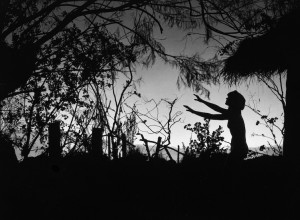 When Laura joins the spinsters in their hotel room and the psychic channels the dead daughter, there is something unmistakeably erotic about the scene, and it reveals just what it is that has always invited the (male) hatred and fear of witches. The heresy of witchcraft isn’t any more about truck with the devil than “riding broomsticks” is about transportation; it’s really about female sexuality and female enjoyment (both sexual and nonsexual), the most fearsome (and fascinating) thing imaginable in the eyes of men.
When Laura joins the spinsters in their hotel room and the psychic channels the dead daughter, there is something unmistakeably erotic about the scene, and it reveals just what it is that has always invited the (male) hatred and fear of witches. The heresy of witchcraft isn’t any more about truck with the devil than “riding broomsticks” is about transportation; it’s really about female sexuality and female enjoyment (both sexual and nonsexual), the most fearsome (and fascinating) thing imaginable in the eyes of men.
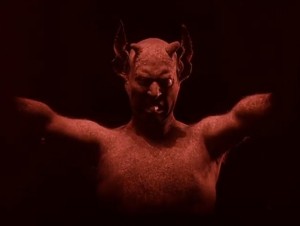 Danish director Benjamin Christensen veered close to the sexual dimensions of witchcraft-fear in his wonderful 1922 documentary Haxan: Witchcraft through the Ages (which I first saw at a 1999 Edinburgh horror film festival in a sublime double bill with another of my desert island top 5 films, The Wicker Man). Drawing on the then-current theories of Freud, Christensen linked witchcraft to hysteria and the libidinal dysfunctions and misdirections that beset females in repressive European society, as well as to the ignorant credulity of elderly widows and spinsters. A masterful early documentary that incorporates entertaining reenactments, Haxan manages to treat the subject intelligently and seriously but also have a sense of humor about it. The director himself appears as the devil, flicking his tongue seductively at his victims, including a troubled sleepwalking nun; the frenzied madness that takes over a convent after the nun defiles the chapel is alone worth the price of admission.
Danish director Benjamin Christensen veered close to the sexual dimensions of witchcraft-fear in his wonderful 1922 documentary Haxan: Witchcraft through the Ages (which I first saw at a 1999 Edinburgh horror film festival in a sublime double bill with another of my desert island top 5 films, The Wicker Man). Drawing on the then-current theories of Freud, Christensen linked witchcraft to hysteria and the libidinal dysfunctions and misdirections that beset females in repressive European society, as well as to the ignorant credulity of elderly widows and spinsters. A masterful early documentary that incorporates entertaining reenactments, Haxan manages to treat the subject intelligently and seriously but also have a sense of humor about it. The director himself appears as the devil, flicking his tongue seductively at his victims, including a troubled sleepwalking nun; the frenzied madness that takes over a convent after the nun defiles the chapel is alone worth the price of admission.
 The theme of nuns driven to sexual madness is of course a titillating theme explored in countless nunsploitation (and, I’m sure, porn) films since then. Female enjoyment is something that men really, deep down, suspect doesn’t involve or require men at all and may not even require sex. It is somehow huger and deeper than anything men can fathom or experience, which is both exciting and terrifying. It was intense male fear of (and inability to countenance their own titillation at) women’s solitary and collective sexual enjoyment that got wayward nuns, lonely spinsters, and lesbians burned at the stake during the Middle Ages; their theological transgressions were smokescreen for what was really an issue of sexual fear.
The theme of nuns driven to sexual madness is of course a titillating theme explored in countless nunsploitation (and, I’m sure, porn) films since then. Female enjoyment is something that men really, deep down, suspect doesn’t involve or require men at all and may not even require sex. It is somehow huger and deeper than anything men can fathom or experience, which is both exciting and terrifying. It was intense male fear of (and inability to countenance their own titillation at) women’s solitary and collective sexual enjoyment that got wayward nuns, lonely spinsters, and lesbians burned at the stake during the Middle Ages; their theological transgressions were smokescreen for what was really an issue of sexual fear.
Stolen Enjoyment
A basic theme of Lacanian psychoanalysis is that we go through our adult lives unconsciously haunted by a bliss/enjoyment that we dimly remember and feel we lost or had stolen from us when we entered the Symbolic and Imaginary dimensions of civilized life as toddlers—the loss symbolized as “castration.” The notion that that bliss-enjoyment exists out there in the external world, in the possession of some other, is the principle fantasy underlying all forms of sexism, racism, and homophobia: The sexual or ethnic other always somehow enjoys more than we do, and we hate it.
John’s confusion, as he rushes through the maze-like alleys of Venice in search of his ‘abducted’ wife, is a perfect metaphor for the materialist’s confused disavowal of cosmic meaning and psychical bliss.
In actual fact, though, we are the ones suppressing this primordial bliss in ourselves by misattributing it to others. This confusion, or what Žižek would call “perspective mistake”—mistaking our own enjoyment as the property of the other—causes enjoyment to have an anamorphic quality: The farther away we localize it, the huger it seems to be, just like in the “dolly zoom” special effect first used in Vertigo, although in reverse: By shortening the depth of field (zooming in) during a reverse tracking shot, an object appears to terrifyingly grow in size as it becomes more distant, because it fills the same area in the frame but flattens out against its background like things seen through a telescope.
According to this logic, bliss assumes an enormity in the other to the degree we disavow it in ourselves, and this enormity causes us anguish and pain in equal proportion. Thus the French term “jouissance”—connoting pleasure in pain or painful pleasure—has a deeply ambivalent or equivocal meaning in the writings of Lacanians like Žižek. For Žižek, jouissance, usually translated as enjoyment, more often means horror and disgust than it does anything actually enjoyable or pleasurable. But this really represents the fundamental pathology that materialists, who are stereotypically male, suffer from. Historically, men’s distrust of female enjoyment is really an alienated reaction to their own disavowed bliss-enjoyment, and this manifests as a distrust of that enjoyment’s alternative channels, such as the mystical and paranormal. It is (stereotypically) women who have always been more open to that stuff.
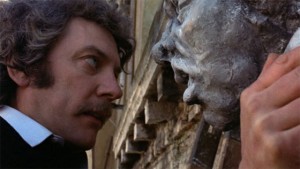 John is an architect who can only see the old church he is restoring in physical terms. While focusing on the material minutiae—matching tiny tiles to a mosaic on a high wall—he is nearly killed when the platform he is standing on collapses. In another church, he impatiently expresses scorn when Laura lights candles and prays. Later his confusion, as he rushes through the maze-like alleys of Venice in search of his ‘abducted’ wife, is a perfect metaphor for the materialist’s confused disavowal of cosmic meaning, so long as we recognize that ‘meaning’ always really boils down to the bliss that is the secret substance of the universe that is already our own possession if we only acknowledge it.
John is an architect who can only see the old church he is restoring in physical terms. While focusing on the material minutiae—matching tiny tiles to a mosaic on a high wall—he is nearly killed when the platform he is standing on collapses. In another church, he impatiently expresses scorn when Laura lights candles and prays. Later his confusion, as he rushes through the maze-like alleys of Venice in search of his ‘abducted’ wife, is a perfect metaphor for the materialist’s confused disavowal of cosmic meaning, so long as we recognize that ‘meaning’ always really boils down to the bliss that is the secret substance of the universe that is already our own possession if we only acknowledge it.
Unable to even imagine that he himself is a carrier of that mystical/psychical bliss, the only place John can localize it is in the menopausal mystics he suspects of abducting his wife. This mistake costs him his life.
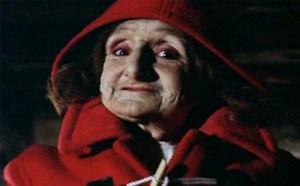




This is one of my top ten films and I think the overall production values gave it an aura of claustrophobic uncertainty that just kept relentlessly building until it evolved into full blown paranoia. Its a nice twist that the objects of his paranoia were largely imaginary and what did him in was ultimately unrelated to what he anticipated. Its one of those films that require the viewers attention to details. The protagonist was fixated on predictability and knowing which piece went where and there was a sublimated sense of his “losing control” that built as well. I enjoyed your review of this film and a great deal of your own point of view neatly fits into another level of its themes.